We went to bed early with the excitement of visiting
Valley of Flowers next day. Everyone was tired after a
long trek from Gobindghat to Ghangria. The hotel we stayed was just opposite Gurudwara. The spiritual tones of Gurbani started at 4.15 waking us up. In fact everyone in Ghangaria wakes up by 4.30 AM and most of the shops are open by 5.30AM.
The morning was cold and we go down to Deepak restaurant – contracted for food by
Indiahikes – to check if he can get two cups of tea. The boy in the kitchen is already up and is in the process of preparing tea for the whole team. We ask him to prepare two cups first and then the rest. He obliges and makes a nice masala tea with Ginger.
As we sip tea, Sohan Singh is ready with hot water. Getting ready, we put on the layers of cloth to make sure we beat the cold. The thermals, followed by a pull over and a jacket. This would keep us warm through the trek.
The team is ready at 6.30 and majority want to have a tea and toast before starting the trek. We all head to Deepak and the boys were ready with hot bread toast roasted in tandoor, smeared with butter and hot tea.
It had rained on the previous night and luckily for us the rain gods show some mercy in the morning. It is cloudy but no rain. Dinesh get all of us together and brief about the trek. We were now raring to go to one of most pristine places on the earth – VALLEY OF FLOWERS
Please click on the pictures to see them in enlarged size and better resolution.
The valley covered by cloud and mist as we start
For the first KM, we walk through the single street market of what is known as Gangaria. The either side of the road has eateries and hotels catering to pilgrims. Gangaria gets converted into a large mule stand in the morning during the season. Pilgrims start bargaining with mule owners and negotiate the best price for their journey to Hemkund Sahib. Fortunately, mules are not allowed inside valley of flowers.
We reach the junction where the trail turns to Valley of flowers. We cross a stream on a make shift bridge; walk on a narrow trail before reaching the entrance gate of Valley of flowers. Dinesh has already purchased the tickets for the park. Our journey into the “Paradise on the earth” starts. The first one KM is a level trail. The forest is unspoiled and it resembles tropical forests with tall pine and juniper trees, moss covered branches and undergrowth. It is fairly an easy start.
The mountains flanking Ghangaria village as seen from the junction
Brinda crossing the first stream

Few minutes into the trek, we see the fabulous sight of a deafening stream gushing through the valley.
“Pushpavati River” says Dinesh. Pushpavati river gushing from the mountains. Notice the height of these mountains

The river in full glory. Milky white and clear waters
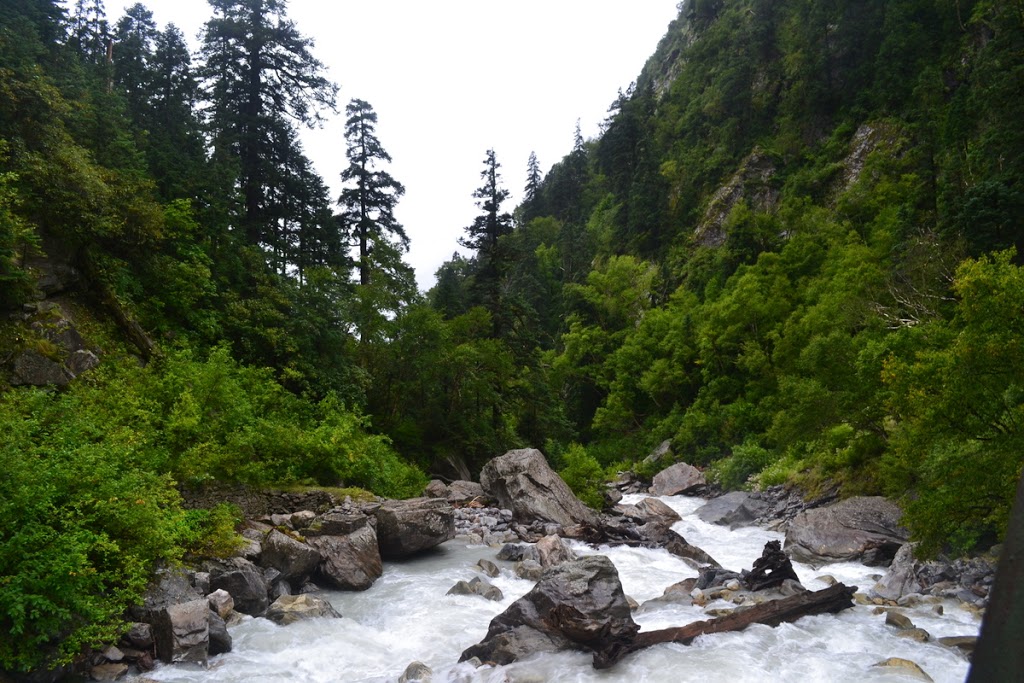

The sight of tall mountains through which the river makes its way humbles us. These mountains are humongously tall. We had never seen anything like this from such a short distance. We walk down the slope to the bridge and cross the river. The milky white waters roaring under the bridge presents a magnificent sight. In the middle is a fallen, huge pine tree, which has been taking the beatings by the water and looks like a massive driftwood.
We now start climbing and the next two KMs is possibly the toughest part of the trek. The trail follows Pushpavati River. We do not see any flowers except for few wild geraniums. Another KM of climbing, we come across level land with mountains at a distance on the other side of the river. The land looks like a white carpet. Dinesh tells us that they are all white flowers. I look into my binoculars and see lovely white flowers spread like a carpet. Dinesh points out to the caves, which are shelters of musk deer on the other side of the river. The crevices of the mountains present a fascinating sight of different varieties of flowers, ferns that I could see only through binoculars. It is a pity that we could not capture them on the lens for lack of hi-end zooms.
This is the tough part of the climb as we climb from the bridge to the valley. Notice the tall mountains and water falls on the flank.
The first view of what is store. White flowers. This is on the left side of the trail as we climb and river is on our right
A close up of the image shows us that it is not just white but has blues, yellows, pinks, violets as well……

We continue to trek and slowly start seeing flowers of different hues. We find yellows, pinks, blues, whites, purples and myriad varieties. Then there are carpets of yellows, whites, pinks and blues.
The yellow spread of Corydalis.
Notice the dried Chremthodiums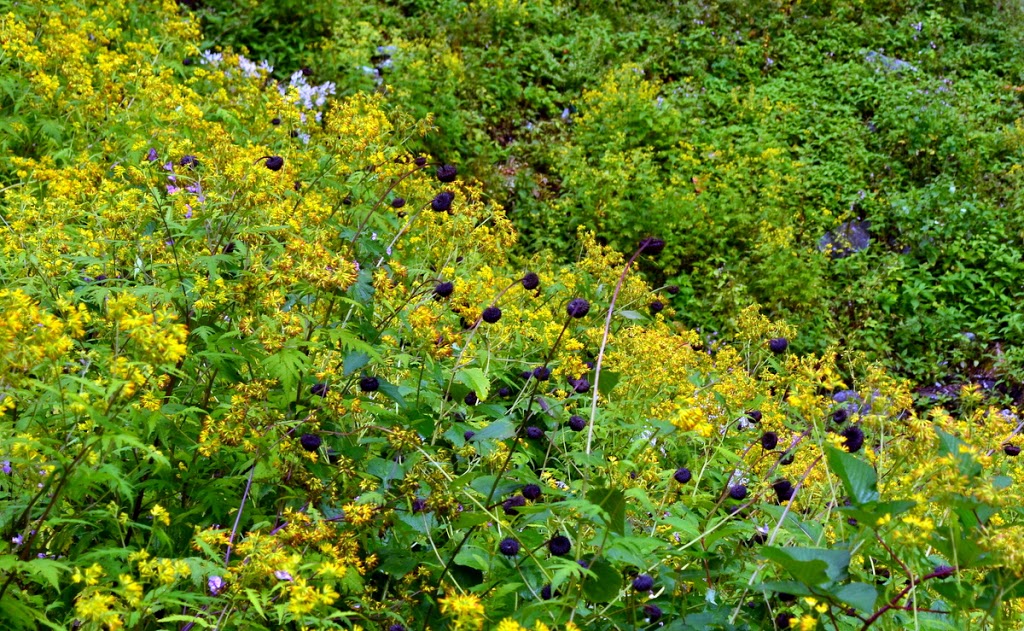
Sprout of Bistorta creating a natural rock garden
The spread of white – Anaphalis

A spread of Pink – Impatiens

The valley opens up and we are presented with an outstanding landscape of tall mountains, lovely water falls, snow covered peaks, green fields with flowers thrown in. The Gauri Parbat and Hathi Parbat at far end of the valley are covered under cloud. We see part of it when the clouds move out. Suddenly we find the clouds clearing and for few seconds we could see the snow capped mountains clearly. It is a “Wow” feeling and a feeling of being one with the nature.
First view of the valley. Covered in clouds.

As we climb we could appreciate the beauty of the valley. Still covered by cloud. 

This is fabulous view of the valley through which we had come through

The green carpet with white sprinkling. This is on the right side of the trail.
As the clouds cleared, we could see an array of water falls trickling from the mountains

The “WoW” moment when the clouds cleared giving us a glimpse of Gauri Parbat and Hathi Parbat
Waterfalls again, covered by myriad flowers
The right side of the trail has this huge mountain with lovely meadows where as the left side is mountains with waterfalls

The flowery trail. Notice different varieties of flowers.

Now it is all pink of Impatiens or wild balsams

Rhododendrons which are the first ones to flower in April – May
The trail passes through the flowering plants on either side
There are myriad varieties of flowers. It requires a closer look and keen eye to differentiate them. The dominant colours are pink, blues, yellow and white. For an untrained, we identify at least forty varieties!! Some of them have bloomed and withered and others about to bloom. Each specie has a different flowering cycle and maximum flowers can be seen between Mid July to Mid August. In fact, we saw many dried wild sunflowers. Rhododendrons were done too. Still the magic of flowers was still on.

We cross a small stream on a makeshift bridge which allows only one person at a time. It is now time for breakfast and we assemble under a huge boulder surrounded by flowers for the breakfast of parata and pickle. Breakfast done and washed with fresh water from the stream, we continue to explore. The valley is huge and it is up to an individual to trek to the best of ability and cover the area. Normally most visitors trek up to the grave of which also gives a chance to see Pushpavati valley at widest. We too trek up to the grave.
Panoramic view of the valley with the river in the middle
Grave of Ms Joan Margaret Legge, the British botanist who on expedition to the valley lost her life when she slipped and fell from a cliff

It is now noon and the getting cloudy. Clouds now cover the peaks and it is turning dark. We do not want to get stuck in the rain and keep our fingers crossed. But we also did not want to miss out seeing more flowers. I walk ahead and point out different varieties of flowers. Brinda is busy with her macro lens clicking away at them. It is good fun spotting these flowers. The sheer variety is astounding. One needs at least two days to explore the valley. In fact, the ticket purchased allows three visits to the valley. But you should have the stamina to do that!!
We are now satiated with our experience of the valley and trek back. We look back one last time at the paradise, which is so beautiful that it can only be experienced and cannot be described. Walking down is easy but one has to be careful lest one may slip. The clouds gather on top of us. As we cross the bridge, we experience a drizzle. We continue to walk back to reality as we reach Gangaria. We are back in the mess of human jungle.
We miss the solitude of the valley which so pristine and beautiful. We had virtually forgotten whole world when we were there and be part of nature for six hours. That was the power of nature.
Travel Tips
a) The trek to Valley of Flowers from Ghangaria is easier than that of Govindghat to Ghangaria.
b) Still, it is a long trek of 14 KMs (7 KM one way). At some places it is really steep.
c) Enjoy the aroma, colours and sounds of the valley. Since mules are not allowed, we are saved from the smell of its droppings.
d) Leaving early in the morning, say 6 AM helps and gives one more time to explore.
e) Weather in the valley is unpredictable. We were fortunate to have a clear weather. Many have come back disappointed due to mist, which spoil the party.
e) A good raincoat is a must. If you haven’t one, you can always get a plastic rain cape in Gangaria by paying Rs 10/-, which serves the purpose.
f) A Macro lens and good wide-angle lens is very helpful. We did have a macro lens. But our 18-55 Nikkor was inadequate to cover the landscape.
g) No need for any guide as the trail is clearly marked.
h) For more adventurous, there is a trail through Valley of Flowers to a village called Ghamshali from where you can join back at Joshimath.
These are few videos we shot during the trek. You will be able to appreciate 360 degree view of the valley through these videos.
Did you like this post? Please share it with your friends by clicking the buttons on side bar if it can be of help to them.























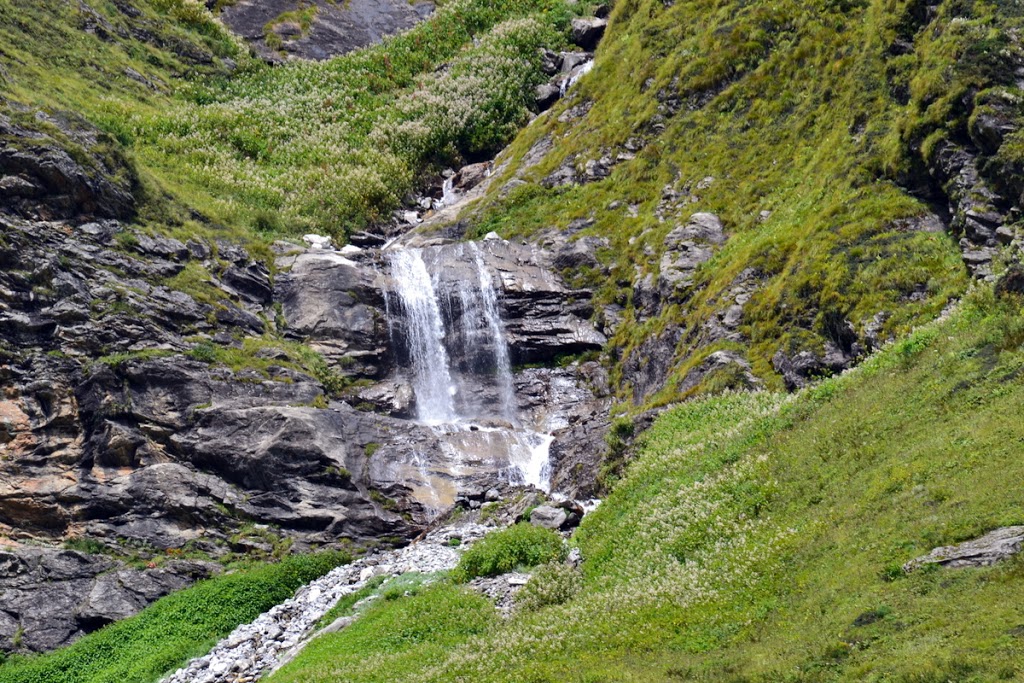








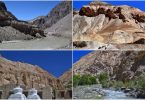
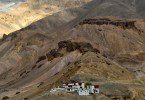




wow beautiful pics!!
Thank you for your comments!!
Really a nice pics to share. Blog related to aroma flowers. Thanks for the sharing such kinds of blog.